Being more interested in spending my pocket money on visiting where mainline diesels were, I seldom went to St Ives unless there was a family run in the car on Sunday afternoon, and the branch line only came into the equation from time to time, so I remember little about it. Each year, however, our Sunday School outing was to Carbis Bay, and we traveled there and back by train. The steep hill up from the beach, the School Treat Saffron Buns, racing for pennies across the sand and the changing huts all still bring happy memories. I can also recall a few visits to Lelant, where a few remains of the former line down to the quay were still in evidence, and walking alongside the railway on the foreshore at low enough tide.
 This view of St Ives taken about 1960 shows the sweep of the line from the left, around before the station building and beyond, under the vegetation covered cliff. A lone carriage is parked in the headshunt, next to advertising hoardings. 60###AF01-SIV-BEACH-VI_NW
This view of St Ives taken about 1960 shows the sweep of the line from the left, around before the station building and beyond, under the vegetation covered cliff. A lone carriage is parked in the headshunt, next to advertising hoardings. 60###AF01-SIV-BEACH-VI_NW

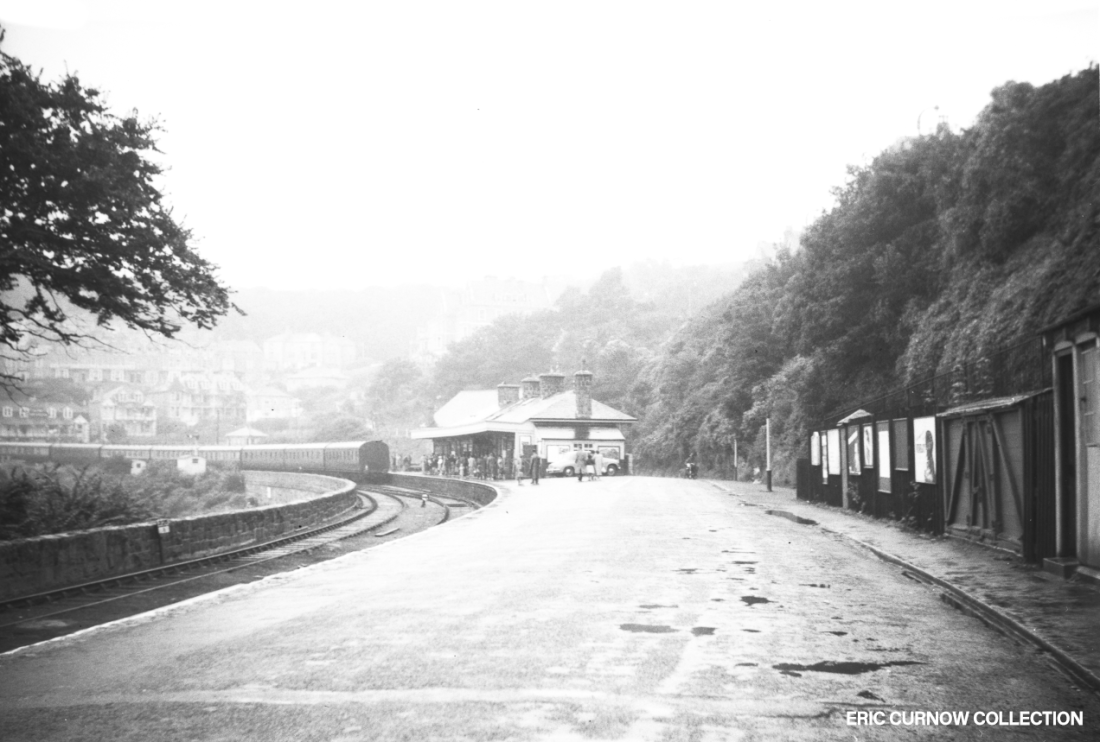 Drizzle is in the air, and puddles are scattered on the landward side of St Ives station’s platform as passengers wait under the awning for their train to be shunted in and made ready, probably in the late 1950s. Poster hoardings, a grounded wagon body and a lightweight building flank the pavement to the right, opposite the track milepost. 5####CV01-SIV-STATN-VI_SE
Drizzle is in the air, and puddles are scattered on the landward side of St Ives station’s platform as passengers wait under the awning for their train to be shunted in and made ready, probably in the late 1950s. Poster hoardings, a grounded wagon body and a lightweight building flank the pavement to the right, opposite the track milepost. 5####CV01-SIV-STATN-VI_SE
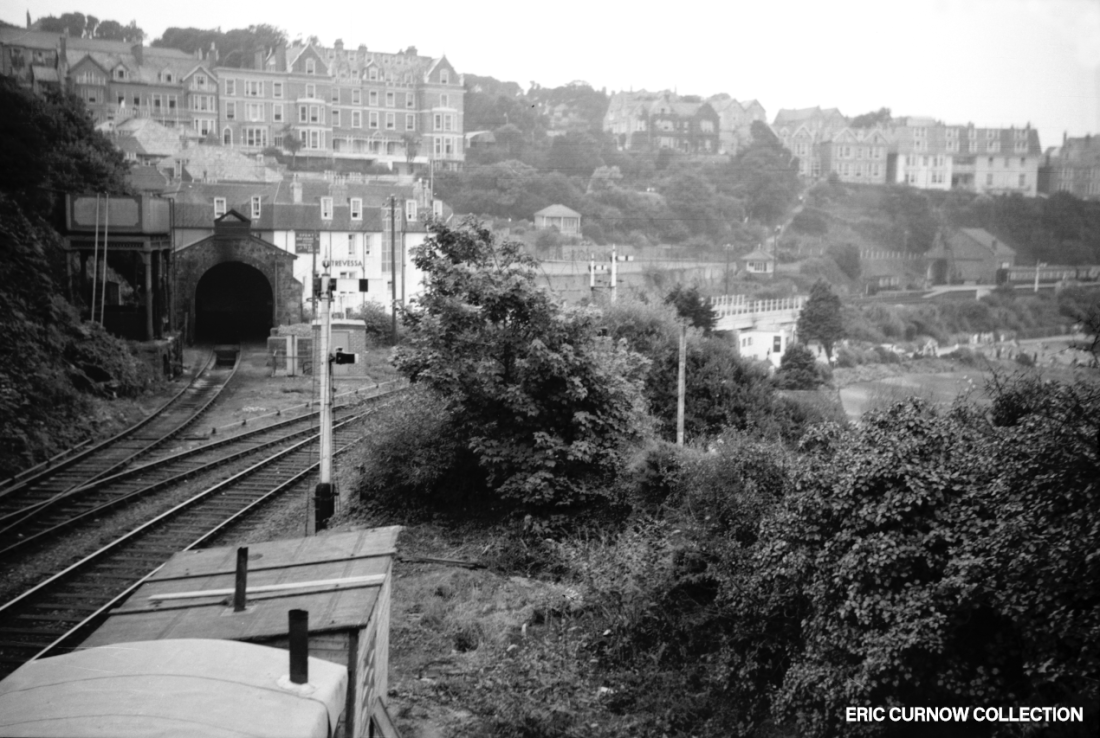 The environs of St Ives station in the 1950s: its wooden signal posts are recently painted and, with the new bridge, everything looks in good order. To the left is the water tower and engine shed; above the bridge railings is the signal box; and on the right, the goods shed and tail end of a train. There is a nice balance of soft vegetation with the, sadly inevitable, buildings. 5####CV01-SIV-STATN-VI_SE
The environs of St Ives station in the 1950s: its wooden signal posts are recently painted and, with the new bridge, everything looks in good order. To the left is the water tower and engine shed; above the bridge railings is the signal box; and on the right, the goods shed and tail end of a train. There is a nice balance of soft vegetation with the, sadly inevitable, buildings. 5####CV01-SIV-STATN-VI_SE
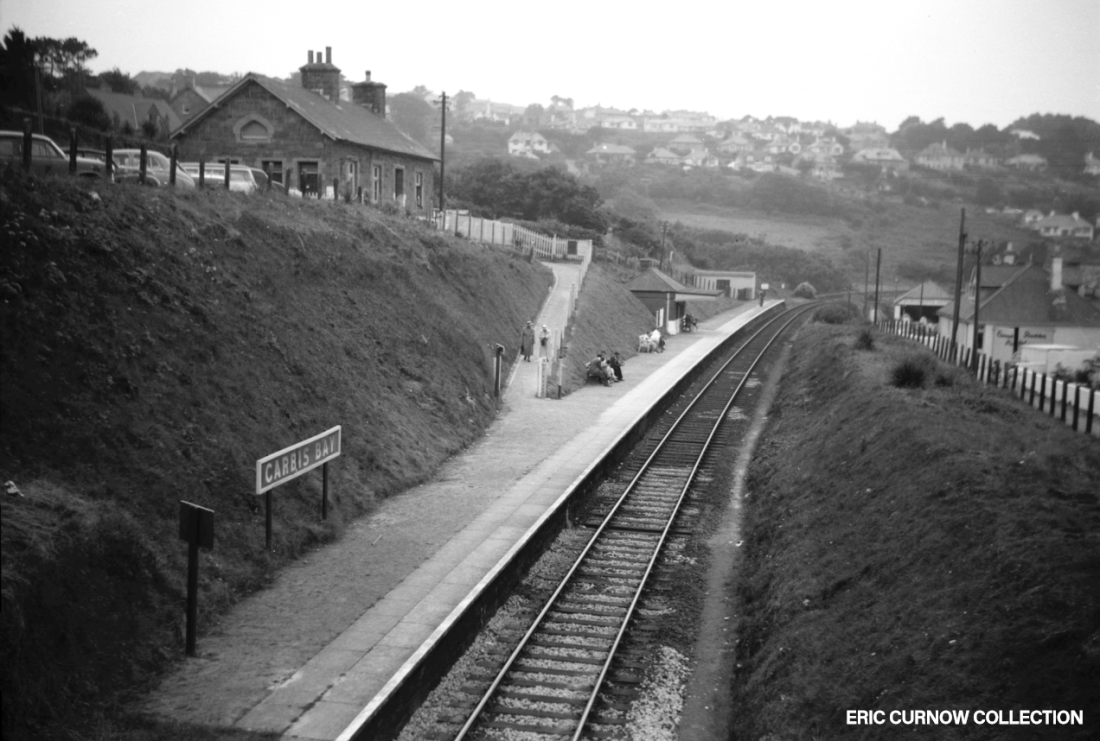
Before nationalisation had made much of its mark on the station, Carbis Bay still has its GWR running in board, as seen from the overbridge to the south east of the station. The granite building always seemed to be sliding downhill to me from this vantage point, but its existence also gives it an air of importance, later lost in the station’s downgrade. 5####CU01-CBB-STATN-VI_NW
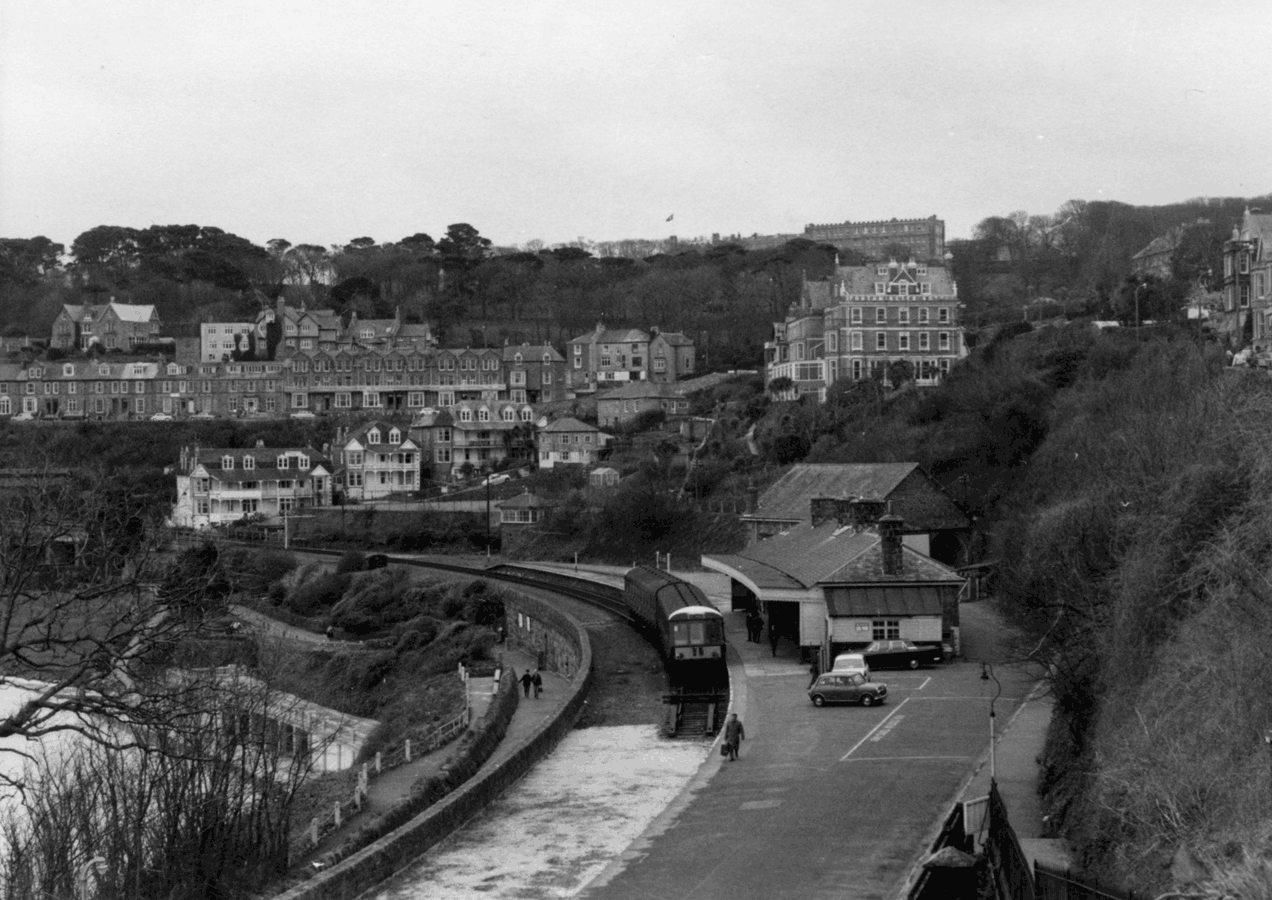 Rationalisation has removed all trackwork except for that of a shuttle line. One passenger walks away from a 2-car DMU in green livery, outnumbered by three station staff talking among themselves. Copyright: Lens of Sutton – John Faulkner Collection. 670325A01-STI-3XDMU-PAS_I
Rationalisation has removed all trackwork except for that of a shuttle line. One passenger walks away from a 2-car DMU in green livery, outnumbered by three station staff talking among themselves. Copyright: Lens of Sutton – John Faulkner Collection. 670325A01-STI-3XDMU-PAS_I
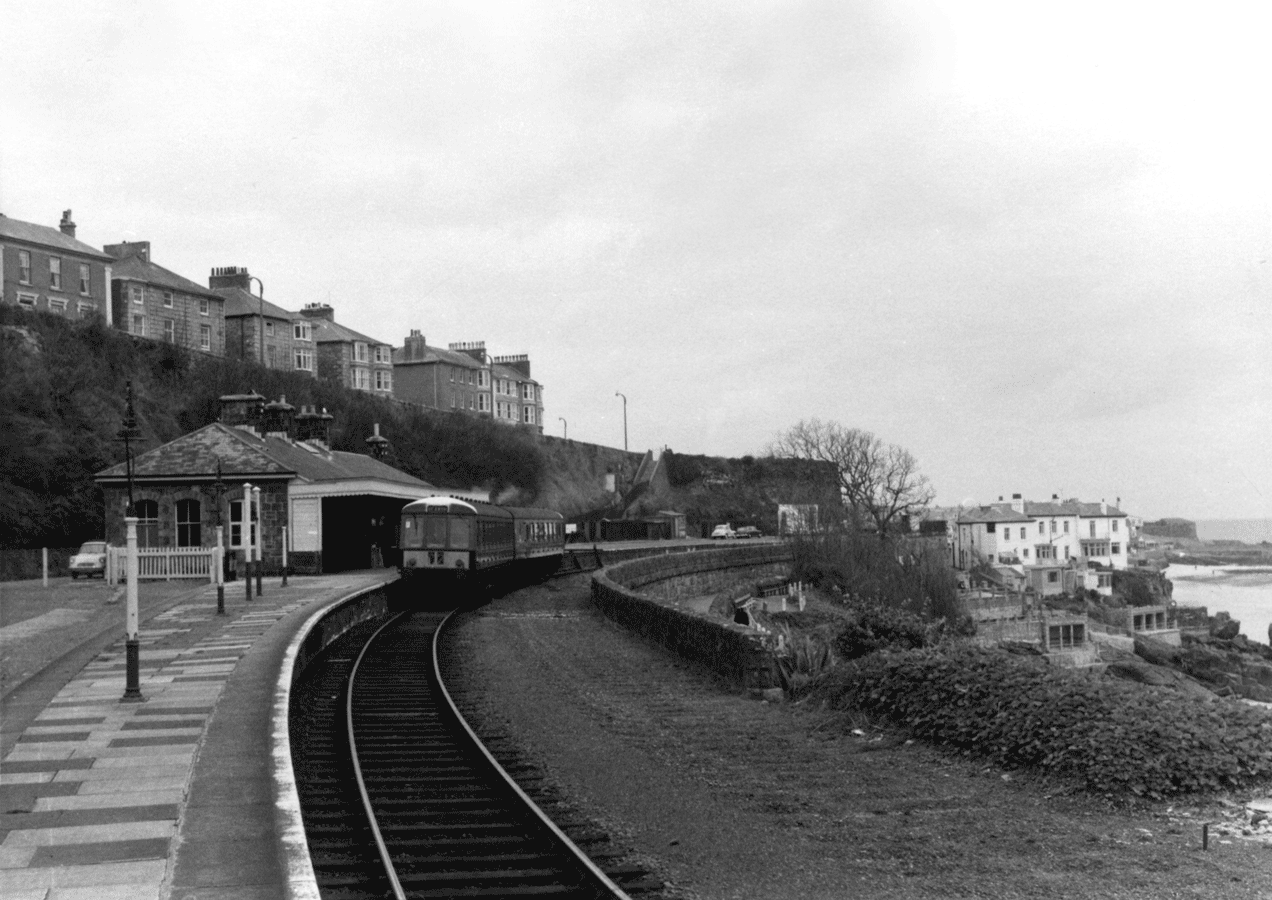
St Ives station mid-rationalisation shows the partially filled in bay platform at front left and the buffer stops brought further away from the town – though the main station building still stands. A 2-car DMU with white window bonnet, largely obscured with exhaust deposit, smokes away awaiting departure. 670325A03-SIV-1XDMU-PAS_I
 A 45XX tank straddles the points at the South Western end of St Ives station on 17th January 1958 as a railman beside the ground disc signal beckons it on. An Engine Shed is under the hill, above the white railings to the loco’s left, and a water tower beyond. 580217A01-SIV-S_YRD-VI_SE
A 45XX tank straddles the points at the South Western end of St Ives station on 17th January 1958 as a railman beside the ground disc signal beckons it on. An Engine Shed is under the hill, above the white railings to the loco’s left, and a water tower beyond. 580217A01-SIV-S_YRD-VI_SE
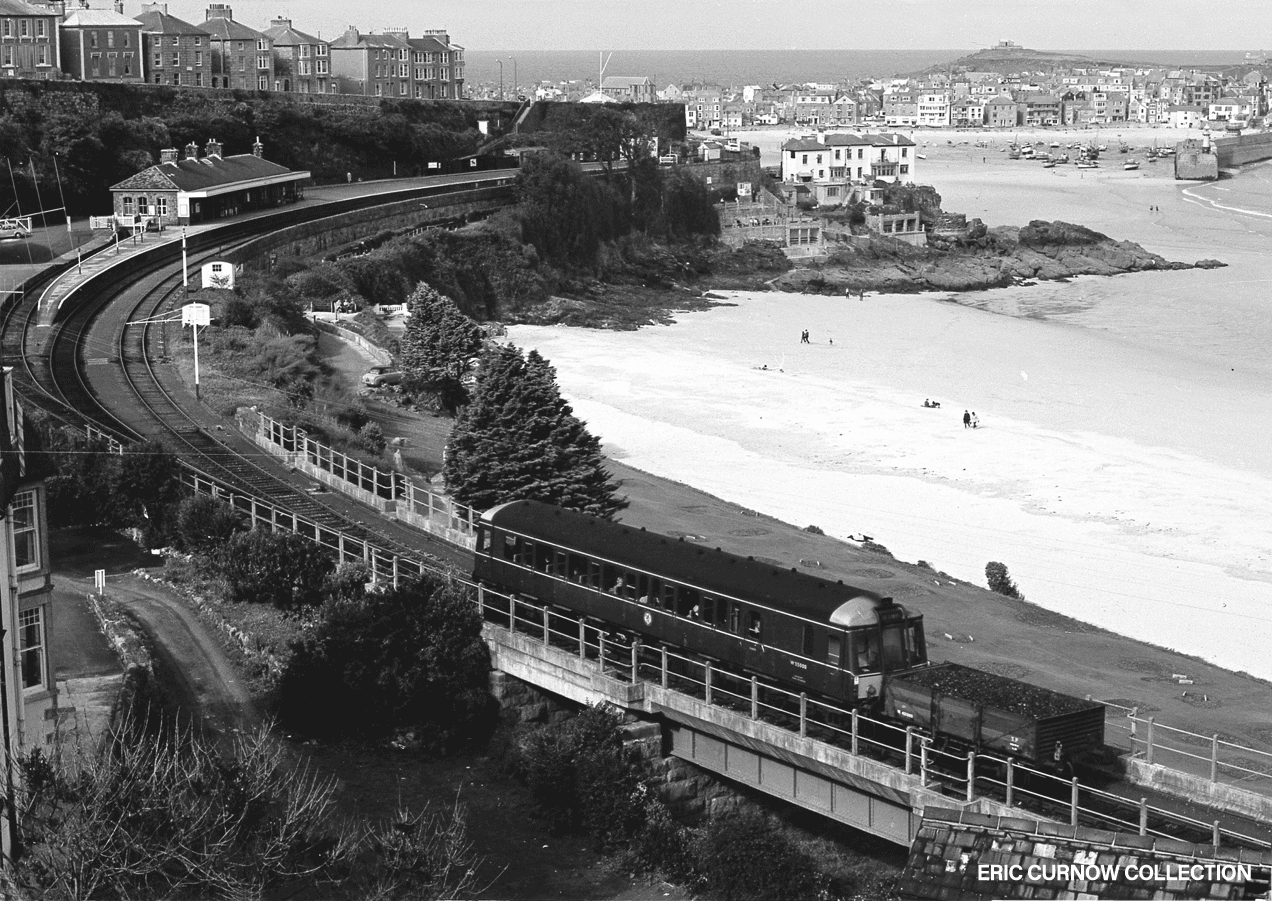 A single unit hauls a 5-plank wagon of coal into St Ives Station. The station is in good order, with everything well painted and clear of unnecessary clutter, but the signal has lost its arm, suggesting significant rationalisation is in progress. 63###AG02-SIV-DMUX1-MXD_O
A single unit hauls a 5-plank wagon of coal into St Ives Station. The station is in good order, with everything well painted and clear of unnecessary clutter, but the signal has lost its arm, suggesting significant rationalisation is in progress. 63###AG02-SIV-DMUX1-MXD_O
 A close-up of the scene above shows the driver in the cab, but no passengers behind him. It is crossing a substantial bridge that when being built encouraged locals to hope that the line wouldn’t be a “Beeching” cut. 63###AG01-SIV-DMUX1-PAS_I
A close-up of the scene above shows the driver in the cab, but no passengers behind him. It is crossing a substantial bridge that when being built encouraged locals to hope that the line wouldn’t be a “Beeching” cut. 63###AG01-SIV-DMUX1-PAS_I
 With a subdued domino headcode, Class 118 DMU set P480 runs out of St Ives station in the 1980s. Rationalisation hit this station severely, although I cannot ever personally recall anything on this branch grander than a basic DMU shuttle back to St Erth. 8####DB01-SIV–P480-PAS_I
With a subdued domino headcode, Class 118 DMU set P480 runs out of St Ives station in the 1980s. Rationalisation hit this station severely, although I cannot ever personally recall anything on this branch grander than a basic DMU shuttle back to St Erth. 8####DB01-SIV–P480-PAS_I
 2-Car P480 leaves St Ives with its exhaust drifting inland. It is running over the bridge across the top edge of Porthminster beach, the track of which then rises to mid cliff height for the majority of the journey to Lelant – giving spectacular views. 7####AR01-SIV–P480-PAS_I
2-Car P480 leaves St Ives with its exhaust drifting inland. It is running over the bridge across the top edge of Porthminster beach, the track of which then rises to mid cliff height for the majority of the journey to Lelant – giving spectacular views. 7####AR01-SIV–P480-PAS_I
 Gently rocking as it nears the point at Carrack Gladden, 2-car unit P463 trundles slowly along, the schedule permitting plenty of time for travelers to take in the view, though marred by a mist, The water usually is of an exceptional colour along this stretch. 7####EZ01-CBB–P463-PAS_O
Gently rocking as it nears the point at Carrack Gladden, 2-car unit P463 trundles slowly along, the schedule permitting plenty of time for travelers to take in the view, though marred by a mist, The water usually is of an exceptional colour along this stretch. 7####EZ01-CBB–P463-PAS_O
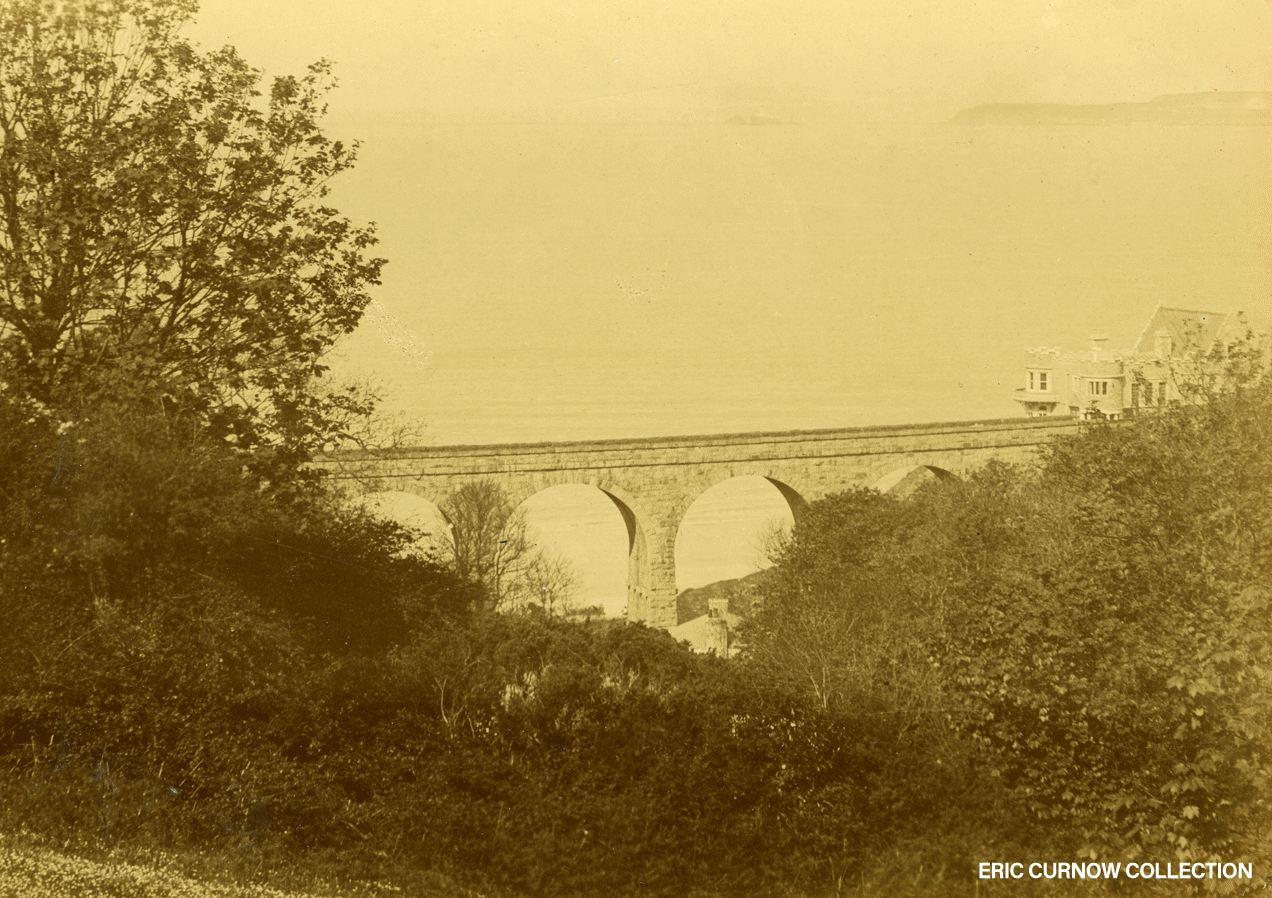 The viaduct at Carbis Bay is pictured on a misty day where gentle wave ripples can be seen, and even Godrevy island. A castellated house peeps over the eastern end and a few rooftops can be seen below the masonry between lush vegetation. #####AL01-CBB-VIADT-VI_NE
The viaduct at Carbis Bay is pictured on a misty day where gentle wave ripples can be seen, and even Godrevy island. A castellated house peeps over the eastern end and a few rooftops can be seen below the masonry between lush vegetation. #####AL01-CBB-VIADT-VI_NE
 The fixed distant west of Carbis Bay stands alongside a track resting on bridges, next to where a milepost leans seaward, and is shadowed on its inland side by a footpath. A typical fence of point-topped wooden posts with wire strands separates the two. 45###AA01-CBB-TRACK-VI_NW
The fixed distant west of Carbis Bay stands alongside a track resting on bridges, next to where a milepost leans seaward, and is shadowed on its inland side by a footpath. A typical fence of point-topped wooden posts with wire strands separates the two. 45###AA01-CBB-TRACK-VI_NW
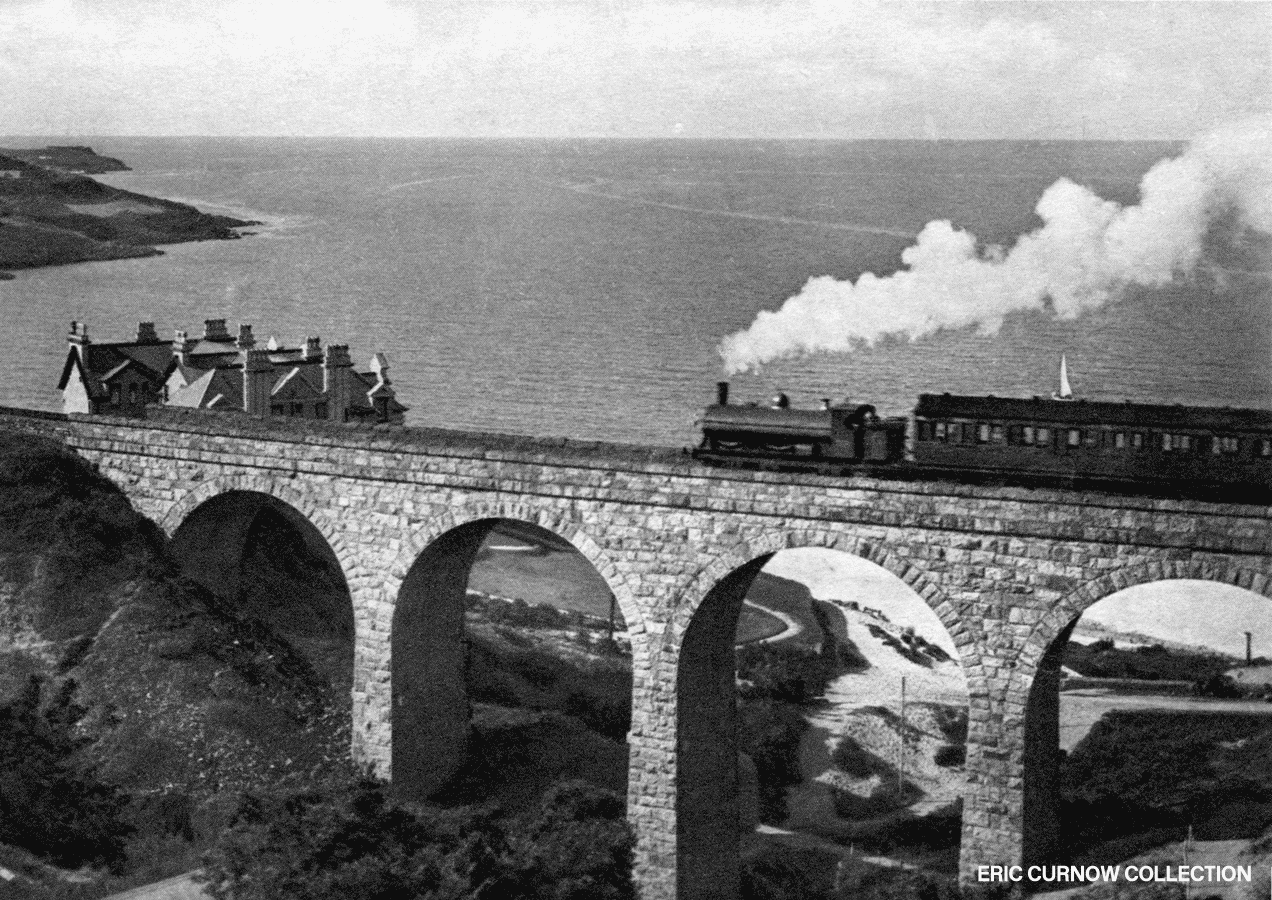 In the days before the area was built up with housing, an 0-6-0 steam loco crosses the valley west of Carbis Bay station, opposite the hotel. The viaduct masonry is still unblemished and the approach debris pile has little undergrowth upon it, suggesting this is not long after completion. 2####AG02-CBB-VIADT-VI_NW
In the days before the area was built up with housing, an 0-6-0 steam loco crosses the valley west of Carbis Bay station, opposite the hotel. The viaduct masonry is still unblemished and the approach debris pile has little undergrowth upon it, suggesting this is not long after completion. 2####AG02-CBB-VIADT-VI_NW
 4566 with another classmate “ticks” slowly as it draws into Carbis Bay Station in the late 1950s. I remember seeing the station name still picked out in bricks in the mid 60s. By kind permission R.K. Blencowe. COPYRIGHT R. K. Blencowe Negative Archive Tel: 01794 502733 Email: r.blencowe@ntlworld.com 5####BW01-CBB-sLOCO-PAS_I
4566 with another classmate “ticks” slowly as it draws into Carbis Bay Station in the late 1950s. I remember seeing the station name still picked out in bricks in the mid 60s. By kind permission R.K. Blencowe. COPYRIGHT R. K. Blencowe Negative Archive Tel: 01794 502733 Email: r.blencowe@ntlworld.com 5####BW01-CBB-sLOCO-PAS_I
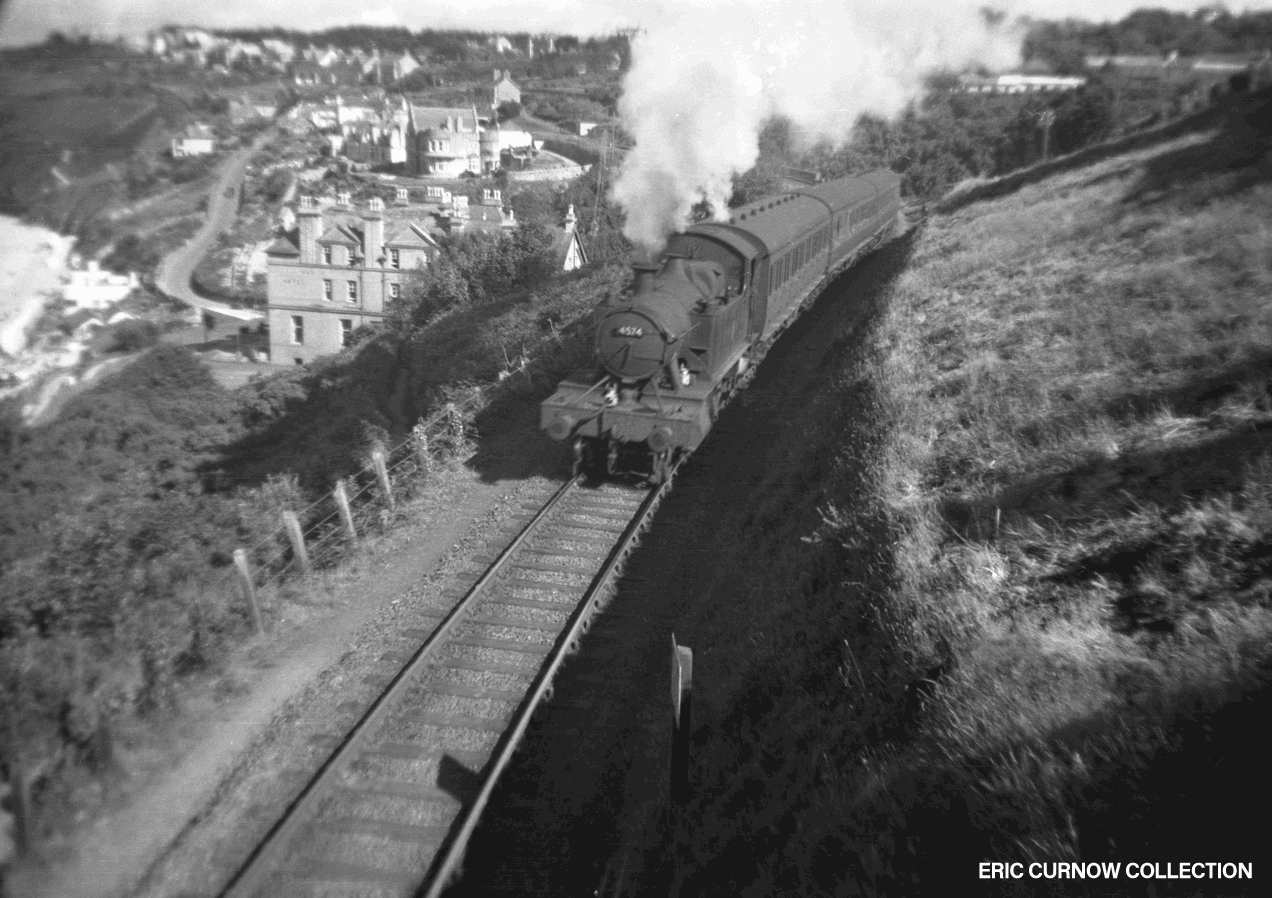 Time was really running out for steam traction when 4574 was pictured from the footbridge to the west of Carbis Bay heading a three coach train to St Ives. A trespass warning sign is placed opposite where I remember, later, placing a penny or two on the track. 620717A01-CBB-s4574-PAS_O
Time was really running out for steam traction when 4574 was pictured from the footbridge to the west of Carbis Bay heading a three coach train to St Ives. A trespass warning sign is placed opposite where I remember, later, placing a penny or two on the track. 620717A01-CBB-s4574-PAS_O
 A DMU passes through Carbis Bay, before rationalisation swept away this shelter, and the Station Building further up the hill behind behind. A temporary storage facility has been erected at the St Ives end of the platform. 640621A01-CBB-PLTFM-VIS_W
A DMU passes through Carbis Bay, before rationalisation swept away this shelter, and the Station Building further up the hill behind behind. A temporary storage facility has been erected at the St Ives end of the platform. 640621A01-CBB-PLTFM-VIS_W
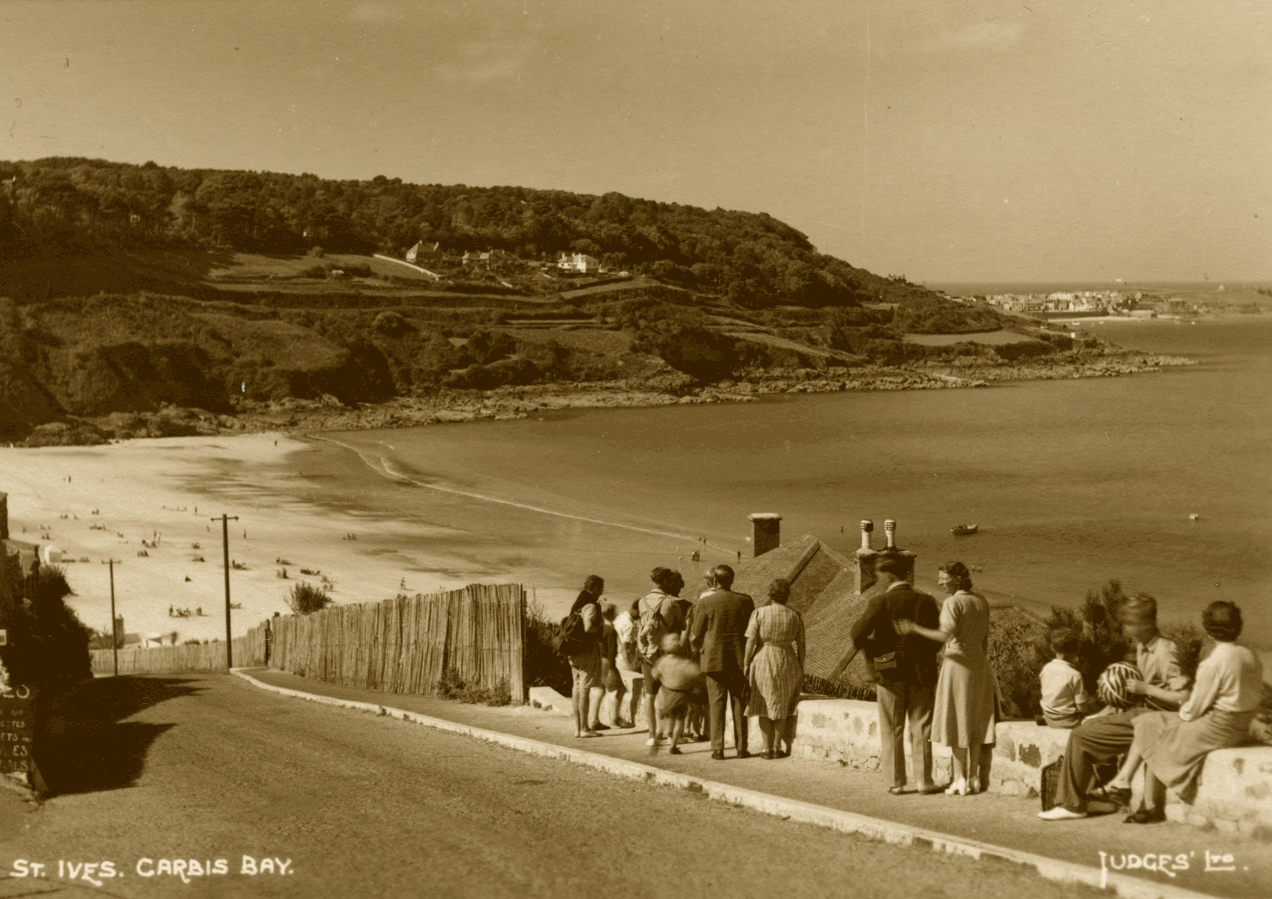 An experience that sticks in my memory is this steep hill down from Carbis Bay Railway Station to the beach – excitement, balls running away, relief in resting on this wall on the way up, etc. The undulation half way up the coast behind shows the course of the railway. 5####BR01-CBB-BEACH-VI_NW
An experience that sticks in my memory is this steep hill down from Carbis Bay Railway Station to the beach – excitement, balls running away, relief in resting on this wall on the way up, etc. The undulation half way up the coast behind shows the course of the railway. 5####BR01-CBB-BEACH-VI_NW
 A view from the cab of a St Ives bound DMU shows people ambling along the platform to a better position to board. The shelter has lost its awning, the covered noticeboard is still beside it, and the temporary store at the foot of the far path down has been removed. 68###AA01-CBB-DMUX3-PAS_O
A view from the cab of a St Ives bound DMU shows people ambling along the platform to a better position to board. The shelter has lost its awning, the covered noticeboard is still beside it, and the temporary store at the foot of the far path down has been removed. 68###AA01-CBB-DMUX3-PAS_O
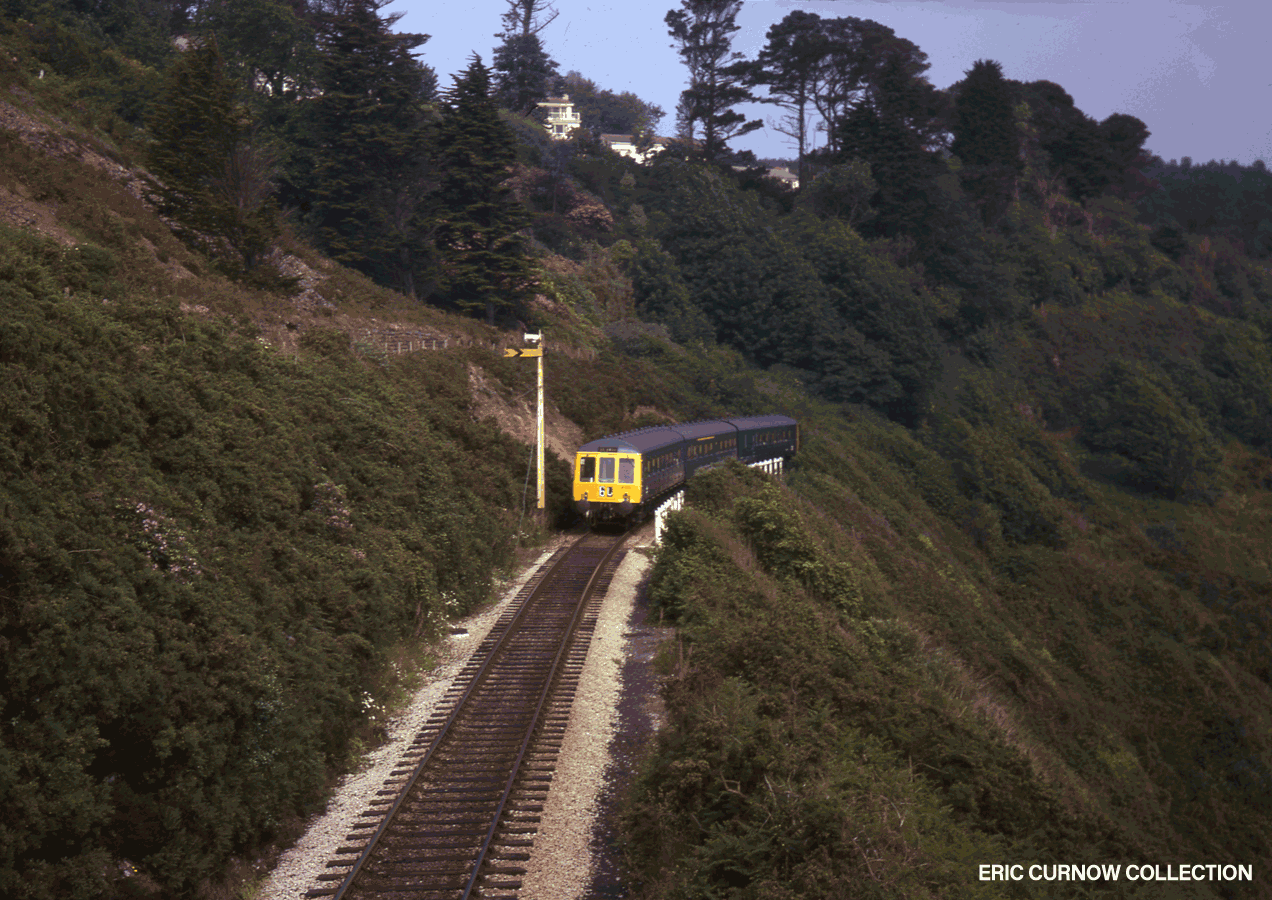 A 3-Car DMU set motors past the fixed distant signal across the pair of bridges to the west of Carbis Bay, viewed from that footbridge. As kids, we would see the train rounding the point from the beach, and try to race to the bridge before the train reached it. 74###AB01-CBB-DMUX3-PAS_I
A 3-Car DMU set motors past the fixed distant signal across the pair of bridges to the west of Carbis Bay, viewed from that footbridge. As kids, we would see the train rounding the point from the beach, and try to race to the bridge before the train reached it. 74###AB01-CBB-DMUX3-PAS_I
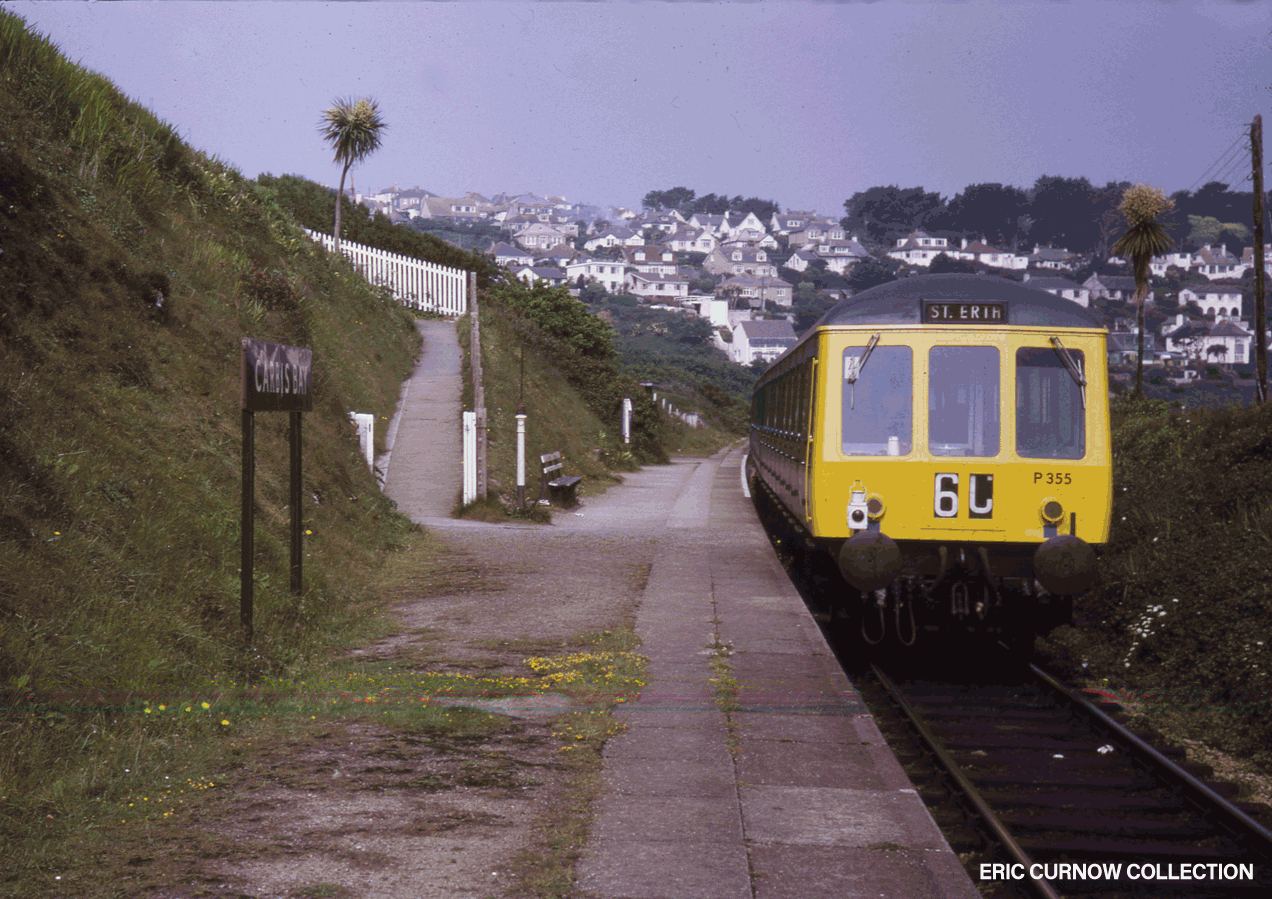 P355 is paused at a much rationalised Carbis Bay station. On the platform, the shelter and noticeboard have gone, but the maroon and cream sign board of 1950s origin is still in place. The Station Building at the top of the rising fenced path is also no more. 740615A01-CBB-DMUX3-PAS_O+
P355 is paused at a much rationalised Carbis Bay station. On the platform, the shelter and noticeboard have gone, but the maroon and cream sign board of 1950s origin is still in place. The Station Building at the top of the rising fenced path is also no more. 740615A01-CBB-DMUX3-PAS_O+

A telephoto shot of a scene familiar to me is taken in 1974 from St Ives of a departing 3-car Class 116 DMU, exhaust smoking away, about to pass under the overbridge at Porthminster Point. As there is very little on the seaward side of the bridge, it is a wonder such a structure exists, but presumably there was a dwelling there requiring one in times gone by. 74###AM01-SIV-3XDMU-PAS_I

Gently rocking as it nears the point at Carrack Gladden, 2-car unit P463 trundles slowly along, the schedule permitting plenty of time for travelers to take in the view, though marred by a mist, The water usually is of an exceptional colour along this stretch. 7####EZ01-CBB—P463-PAS_O
 This is a view from the train about two thirds of the way between St Erth and St Ives – the rock outcrop dividing Porthkidney Sands at the Hayle Estuary and Carbis Bay. This whole line in the 70s had marvelous views, until vegetation was not cut back each year. 780823A01-LEL-COAST-VI__N
This is a view from the train about two thirds of the way between St Erth and St Ives – the rock outcrop dividing Porthkidney Sands at the Hayle Estuary and Carbis Bay. This whole line in the 70s had marvelous views, until vegetation was not cut back each year. 780823A01-LEL-COAST-VI__N
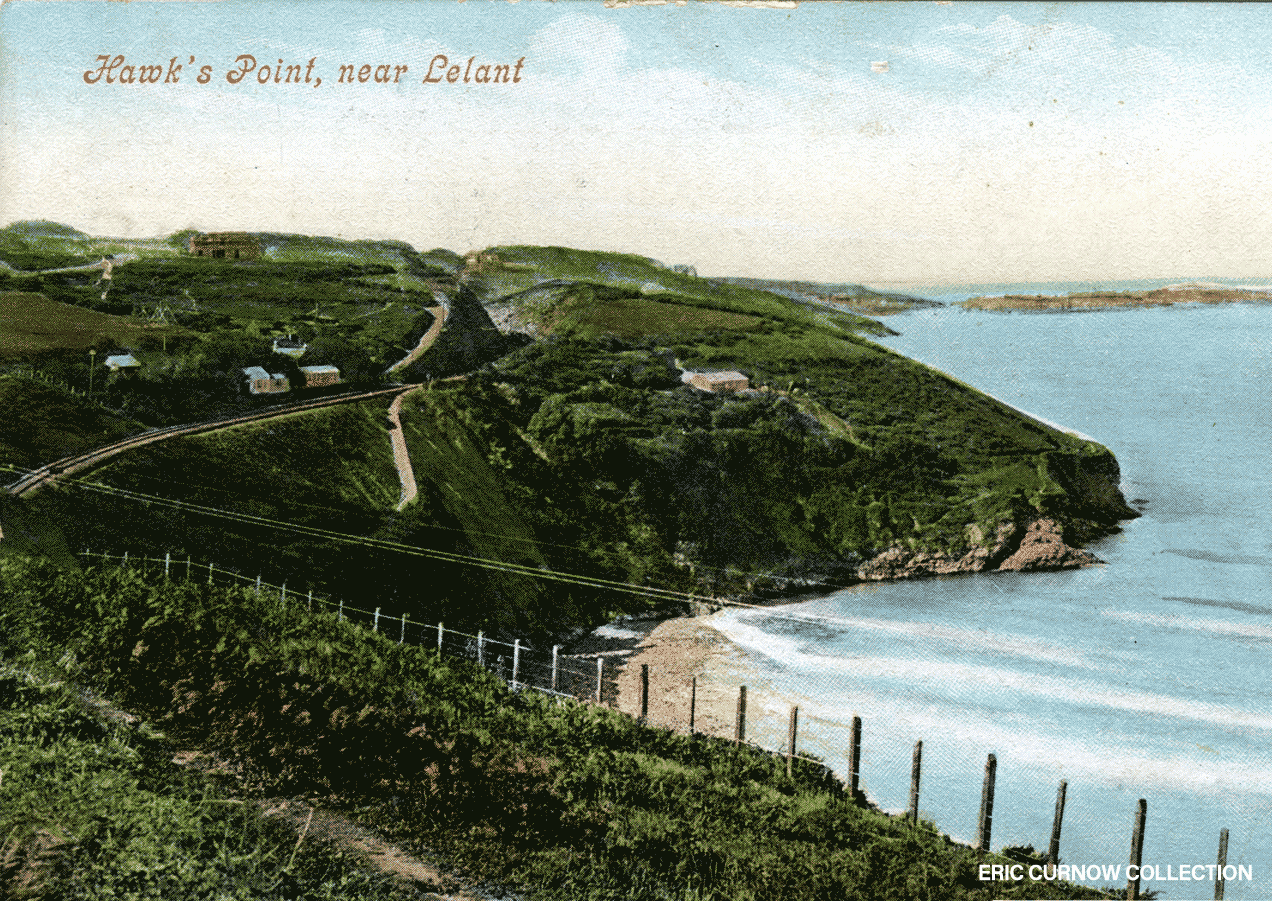
The huge cutting at Hawk’s Point between Carbis Bay and Lelant shows the difficulties of connecting St Ives with the main railway system. As is freequent on this stretch, the sinuous winding of the track and sheer drop to the water is accompanied by a footpath a mere few yards from the trackside fencing. 100810A01-CBB-TRACK-VI_NW
 A 1978 view of the sand dunes across the estuary towards Hayle Towans from the branch train from St Erth to St Ives. Lelant has just been passed, and these dunes stretch for half a mile or so towards the terminus. Windows reflect light from holiday homes. 780823A02-LEL-COAST-VI__E
A 1978 view of the sand dunes across the estuary towards Hayle Towans from the branch train from St Erth to St Ives. Lelant has just been passed, and these dunes stretch for half a mile or so towards the terminus. Windows reflect light from holiday homes. 780823A02-LEL-COAST-VI__E
 On a wet day, a 3-Car DMU throbs its way into the platform at Lelant as a potential passenger heads for the best position to board for exiting at St Erth. The Station House is in private hands, fenced off from the railway, and a new building is being erected beside it. 7####EE01-LEL-3XDMU-PAS_I
On a wet day, a 3-Car DMU throbs its way into the platform at Lelant as a potential passenger heads for the best position to board for exiting at St Erth. The Station House is in private hands, fenced off from the railway, and a new building is being erected beside it. 7####EE01-LEL-3XDMU-PAS_I
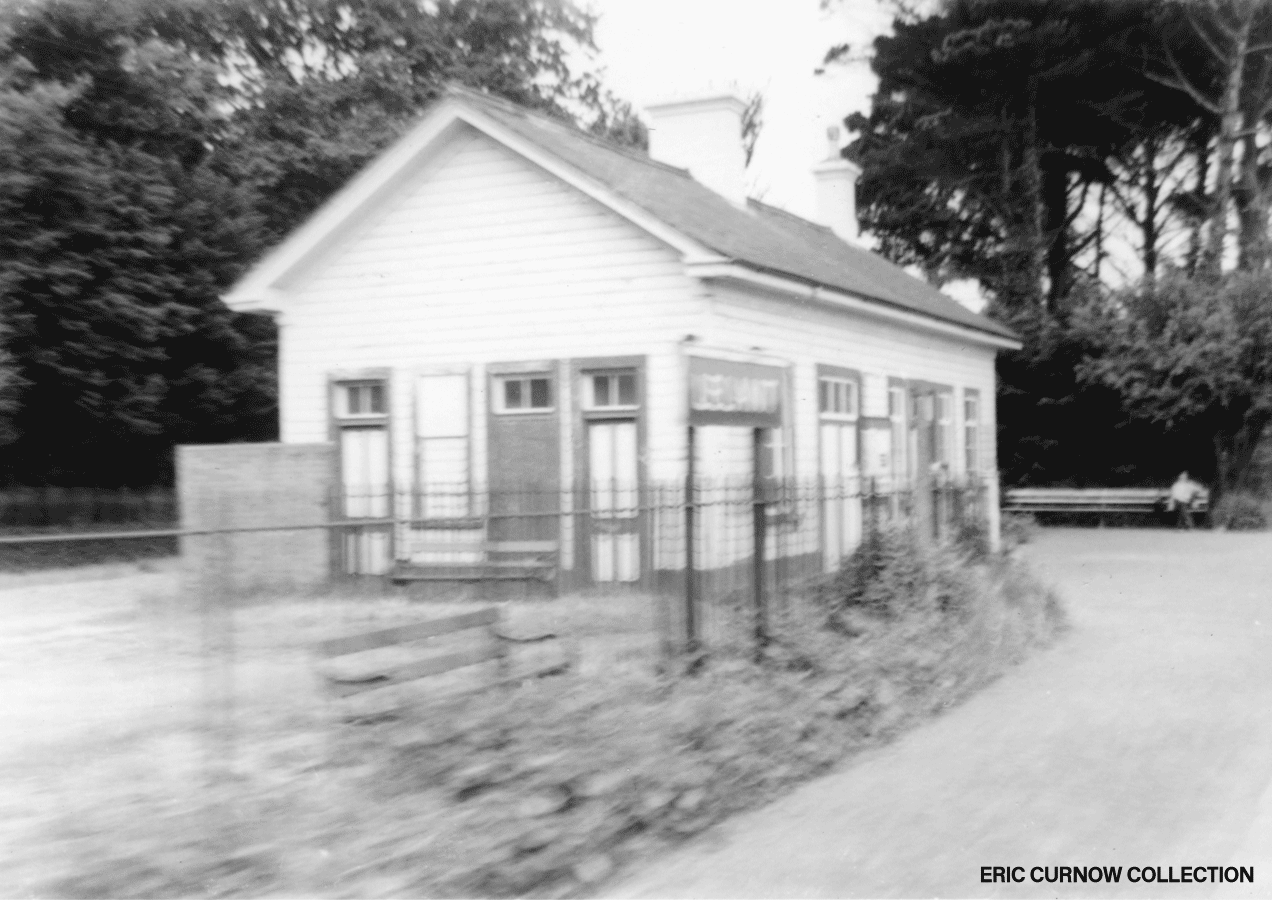 Presumably taken from a non-stopping DMU set, Lelant Station is passed at speed on 21st June 1964. Its large stark white expanse of woodwork made it seem more like a house, … which, of course, it eventually became when de-staffed and sold off. 640621A01-LEL-S_BLG-VI_NW
Presumably taken from a non-stopping DMU set, Lelant Station is passed at speed on 21st June 1964. Its large stark white expanse of woodwork made it seem more like a house, … which, of course, it eventually became when de-staffed and sold off. 640621A01-LEL-S_BLG-VI_NW
Below lighting towers and before an inspection pit, new-to-traffic D1857 and D1858 are pictured with older class mates at Bristol Bath Road in 1964, all in two-tone green livery, with a glimpse of a ‘Western’ behind them. With so many diesel electrics together, it appears “the writing is on the wall” for hydraulics. Photo: William Kerry. 64##AH01-BBR-D_LCO-PARKD
